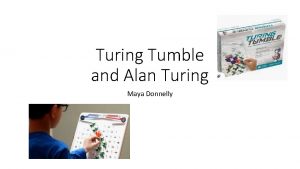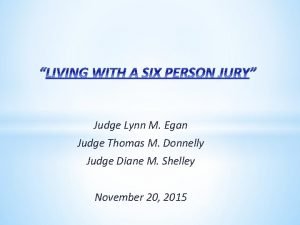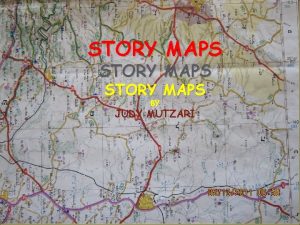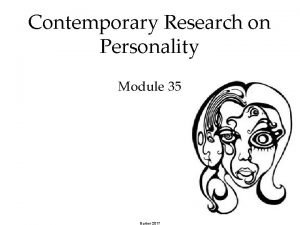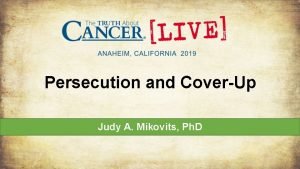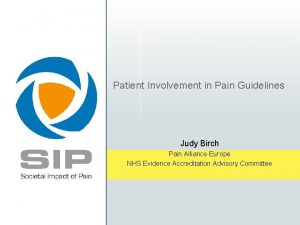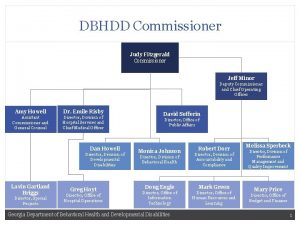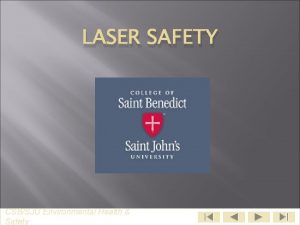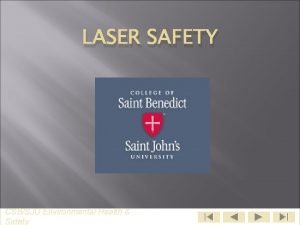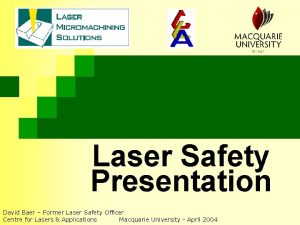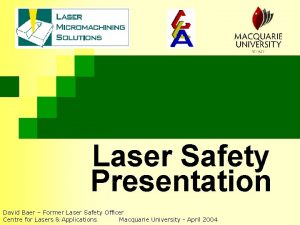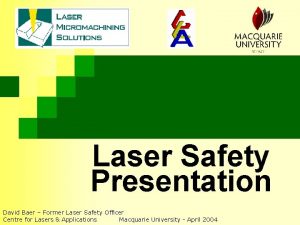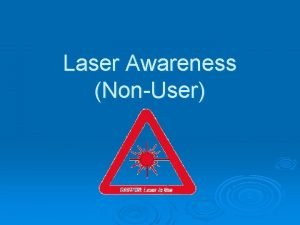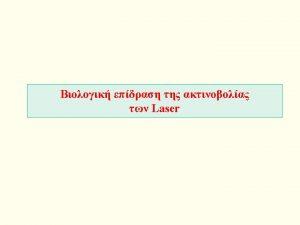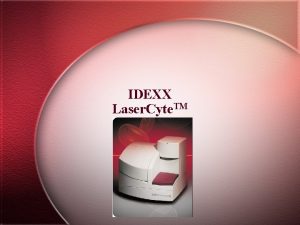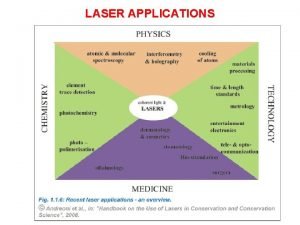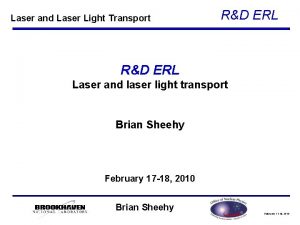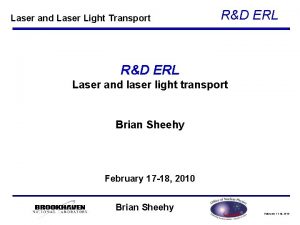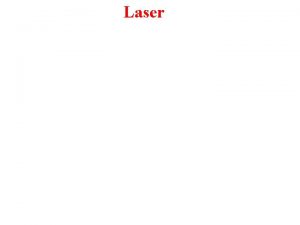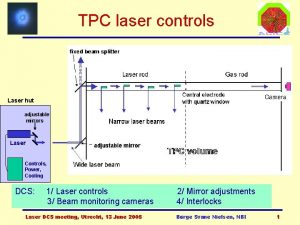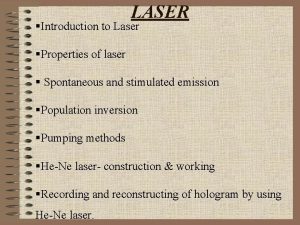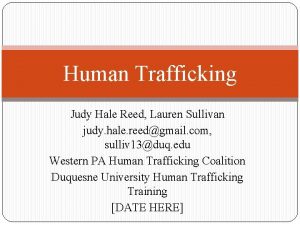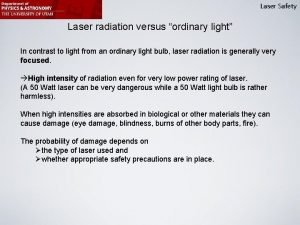Laser Safety Judy Donnelly Three Rivers Community College
































- Slides: 32

Laser Safety Judy Donnelly Three Rivers Community College

CHARACTERISTICS of LASER LIGHT è Monochromatic- “single color” è Coherent- waves are “in phase” è Highly Directional- resulting in very concentrated light energy (high “irradiance”) Judy Donnelly Three Rivers Community College

COMPARE LIGHT FROM A LASER AND A FLASHLIGHT è Monochromatic F laser is single color; flashlight has rainbow spectrum è Coherent F Laser Speckle- due to wave interference è Highly Directional F Flashlight beam spreads much more than laser’s F Define Irradiance = Power/area; laser is lower power but much smaller area Judy Donnelly Three Rivers Community College

What is Irradiance? Irradiance depends on both laser power and on the area being irradiated. It is a concept of central importance in laser safety. The symbol for irradiance is “E”, and the units are usually m. W/cm 2. Judy Donnelly Three Rivers Community College

EXAMPLE: CALCULATION of IRRADIANCE A 5 m. Watt laser makes a 2 mm by 3 mm spot on a wall. Find the irradiance. Power = 5 m. Watt Area = 0. 2 cm x 0. 3 cm = 0. 06 cm 2 Irradiance = Power/Area = 5 m. Watt / 0. 06 cm 2 = 83 m. Watt / cm 2 Judy Donnelly Three Rivers Community College

Laser Safety Standards Several organizations oversee standards for laser safety: ØANSI American National Standards Institute Reference for laser users ØCDRH Center for Devices and Radiological Health Product safety standards for laser manufacturers ØOSHA Occupational Safety and Health Administration Enforces regulations in the workplace ØIEC International Electrotechnical Commission International standards organization, with 60 member countries Judy Donnelly Three Rivers Community College

Laser Eye Hazards The eye is the part of the body most vulnerable to laser hazards. Changes to the eye can occur at much lower laser power levels than changes to the skin. And, eye injuries are generally far more serious (life altering) than injuries to the skin. lens cornea retina fovea optic nerve pupil iris Judy Donnelly Three Rivers Community College

Absorption of Light by the Eye Lens Cornea Mid and Far IR(1400 nm-1 mm) Mid UV (180 nm-315 nm) Laser Wavelength Region IR-C = 1 mm to 1400 nm IR-B = 3000 nm to 1400 nm Near UV (315 nm-400 nm) IR-A = 1400 nm to 700 nm Visible light = 700 nm to 400 nm UV-A = 400 nm to 315 nm UV-B = 315 nm to 280 nm Visible and Near IR (400 nm-1400 nm) UV-C = 280 nm to 100 nm Judy Donnelly Three Rivers Community College Retina

Irradiance at the Retina Example A laser pointer produces a 2 -m. W beam. The beam enters the eye and is focused by the cornea and lens to a spot on the retina 16 um in diameter. Find: The irradiance on the retina, assuming that all of the 2 m. W of power is focused on the retina. Solution: Area of spot A = d 2/4 = (1. 6 x 10 -3 cm)2/4 = 2 x 10 -6 cm 2 lens cornea retina Irradiance: pupil E = P/A = 2 m. W/[2 x 10 -6 cm 2] = 1000 W/cm 2 Judy Donnelly Three Rivers Community College Rule of thumb: The optics of the eye increase irradiance by a factor of 100, 000!

Example of retinal damage due to laser exposure Judy Donnelly Three Rivers Community College

Not all viewing conditions are the same Specular reflection Convex reflector Concave reflector Whether a reflection is specular or diffuse for a given surface depends on the laser wavelength. “Smooth” is relative to the laser wavelength. Diffuse reflection Judy Donnelly Three Rivers Community College

LASER SKIN HAZARDS • Thermal hazards (skin burns) from high level of optical radiation • Photochemical hazards (accelerated aging and risk of skin cancer) due to ultraviolet radiation Judy Donnelly Three Rivers Community College

NONBEAM HAZARDS There are several nonbeam potential hazards associated with the use of lasers and laser systems. 1. 2. 3. 4. 5. 6. Fire hazard Explosion hazard Electrical hazard Chemical hazard Laser generated air contaminants (LGAC) Other hazards Although loss of sight may be life altering, electrocution is the hazard most likely to end life! Judy Donnelly Three Rivers Community College

NONBEAM HAZARDS êFIRE HAZARD Class 4 laser systems represent a fire hazard. Irradiances exceeding 10 W/cm 2 or beam powers exceeding 0. 5 W. The use of flame-retardant materials is advisable and necessary. Fires have occurred in medical facilities where oxygen provides an explosive environment. Judy Donnelly Three Rivers Community College

NONBEAM HAZARDS êEXPLOSION HAZARD High-pressure arc lamps, filament lamps, and capacitor banks in laser equipment shall be enclosed resulting from component disintegration. The laser target and elements of the optical train that may shatter during laser operation shall also be enclosed or equivalently protected to prevent injury to operators and observers. Explosive reactions of chemical laser reactants or other laser gases may be a concern in some cases. Judy Donnelly Three Rivers Community College

êNONBEAM HAZARDS êELECTRICAL HAZARD This may occur from contact with exposed utility power use, device control, and power-supply conductors operating at potentials of 50 volts and above. These exposures can occur during laser setup or installation, maintenance, and service Judy Donnelly Three Rivers Community College

NONBEAM HAZARDS êELECTRICAL HAZARD The following potential problems have frequently been identified during laser facility audits. 1. Uncovered electrical terminals 2. Improperly insulated electrical terminals 3. Hidden “power-up” warning lights 4. Non-earth-grounded or improperly grounded laser equipment Judy Donnelly Three Rivers Community College

NONBEAM HAZARDS êCHEMICAL HAZARDS Certain dyes are highly toxic or carcinogenic. These dyes frequently have to be changed, special care must be taken when handling, preparing solutions, and operating dye lasers. Judy Donnelly Three Rivers Community College

NONBEAM HAZARDS êLASER GENERATED AIR CONTAMINANTS LGAC result from the interaction of high-energy laser radiation, assist gases used in material processing, and the material itself. When lasers are used in a medical setting, particles of biological origin such as bacteria may be released into the air. Air filters and/or ventilation systems are usually required. Judy Donnelly Three Rivers Community College

NONBEAM HAZARDS êOTHER HAZARDS • Compressed gases • Cryogenic liquids Judy Donnelly Three Rivers Community College

Laser Hazard Classifications Class 1: Cannot, under normal operating conditions, emit a hazardous level of optical radiation. Included in this category is laboratory equipment using lasers with all beam paths and reflections enclosed. These are called “embedded lasers. ” Examples: • very low powered lasers (< 0. 4 microwatts) • CD players, laser printers Class 1 M (NEW!) Eye safe unless focused by a optics Judy Donnelly Three Rivers Community College

Laser Hazard Classifications Class 2: low-power visible laser of more than 0. 4 microwatts but less than 1 milliwatt. The eye is protected by the “blink reflex. ” That is, the laser does not have enough output power to injure a person accidentally, but may injure the eye when stared at for a long period. A “caution” label is required. Examples: • Many low power He. Ne lasers, especially in school labs • Lasers used for alignment procedures • Bar Code scanners Class 2 M (NEW!) Visible output, less than 1 m. W, eye safe unless focused by a optics Judy Donnelly Three Rivers Community College

Laser Hazard Classifications Class 3 a lasers—rated in power from 1 milliwatt to 5 milliwatts Will not normally injure a person when viewed briefly with the unaided eye but may cause injury when viewed with a focusing device such as a lens or telescope. A danger or caution sign must label the device, depending on its irradiance. Examples: • many red laser pointers • some He. Ne lab lasers IEC Class 3 R is similar. Judy Donnelly Three Rivers Community College

Laser Hazard Classifications (continued) Class 3 b lasers from 5 milliwatts to 500 milliwatts can produce eye injury when viewed without eye protection. This class of laser requires a danger label and could have dangerous specular reflections. Eye protection is required. EXAMPLES : • 12 m. W He. Ne • 50 m. W He. Cd Judy Donnelly Three Rivers Community College

Laser Hazard Classifications (continued) Class 4 lasers above 500 milliwatts in power can injure you if viewed directly or by viewing either the specular and diffuse reflections of the beam. These lasers can also present a fire hazard. A danger sign will label this laser. Eye and skin protection are required. Judy Donnelly Three Rivers Community College

MAXIMUM PERMISSIBLE EXPOSURE (MPE) Maximum permissible exposure (MPE) limits indicate the greatest exposure that most individuals can tolerate without sustaining injury. MPE depends on: • Wavelength • Output Energy and Power • Size of the Irradiated Area • Duration of Exposure • Pulse Repetition Rate MPE is usually expressed in terms of the allowable exposure time (in seconds) for a given irradiance (in watts/cm 2) at a particular wavelength. MPE’s are useful for determining optical densities for eyewear, filters or windows. Judy Donnelly Three Rivers Community College

Nominal Hazard Zone (NHZ) This zone describes the region within which the level of direct, reflected, or scattered (diffuse) laser radiation is above the allowable MPE. The distance depends on whether or not the beam is direct, focused, or diffused, as well as the power and MPE. LASER d f 0 NHZ illustrated for a focused laser beam Judy Donnelly Three Rivers Community College

Choosing laser eyewear: Optical Density è The ability of a material to absorb light is sometimes expressed in terms of optical density. è Optical density is a logarithmic quantity. è In terms of optical density (OD), transmittance is: Judy Donnelly Three Rivers Community College

Optical Density Example: Laser goggles with OD = 2 at a particular wavelength have a transmittance of The goggles transmit 1% of the incident light at the specific rated wavelength. Judy Donnelly Three Rivers Community College

Optical Density T = 10 -OD OD Transmission %Transmission 0 1 1. 0 100% 1 10– 1 0. 1 10% 2 10– 2 0. 01 1% 3 10– 3 0. 001 0. 1% 4 10– 4 0. 0001 0. 01% 5 10– 5 0. 00001 0. 001% 6 10– 6 0. 000001 0. 0001% 7 10– 7 0. 0000001 0. 00001% Judy Donnelly Three Rivers Community College

Choosing the Optical Density for laser glasses To determine the required OD for safety glasses, compare the irradiation incident on the eye(Eo) to the MPE (what is allowed to be transmitted to the eye) and take the log of the ratio. Judy Donnelly Three Rivers Community College

SAFETY RULES FOR LAB LASERS 1. Avoid looking directly into any laser beam or at its reflection. Be aware of the beam’s location. 1. Only trained qualified personnel should work with lasers Don’t let friends and visitors to the lab play with the lasers 1. Keep room lights on whenever possible 2. Remove all watches, jewel and unnecessary specular (shiny) reflecting surfaces from the work area. 3. Don’t bend down below beam height 4. Use beam blocks 5. Wear laser safety eyewear 6. Report accidents immediately. In the case of eye exposure consult an opthalmologist. Judy Donnelly Three Rivers Community College
 Why are some rivers in texas called “wrong way” rivers?
Why are some rivers in texas called “wrong way” rivers? Oscar donnelly
Oscar donnelly Maya donnelly
Maya donnelly Judge lynn egan
Judge lynn egan Sabrina george
Sabrina george What is unique about mr. donnelly's house?
What is unique about mr. donnelly's house? Judy pineda xxx
Judy pineda xxx Judy map
Judy map Present simple form
Present simple form Simple present form of verbs
Simple present form of verbs Judy believes that her fate
Judy believes that her fate Judy kurtz
Judy kurtz Judy cato
Judy cato Marc inc judy mikovits
Marc inc judy mikovits Ken and judy steele
Ken and judy steele Judy knefati
Judy knefati Butterfly
Butterfly Judy birch
Judy birch Judy chicago dinner party meaning
Judy chicago dinner party meaning Judy williams jessie emily schofield lyrics
Judy williams jessie emily schofield lyrics Judy fitzgerald commissioner
Judy fitzgerald commissioner Judy banfield
Judy banfield Junctional dysrhythmia
Junctional dysrhythmia Filmai kuriuos verta pamatyti
Filmai kuriuos verta pamatyti Judy freed
Judy freed Judy phillips management
Judy phillips management Judy welsh
Judy welsh Judy kazimer
Judy kazimer Albert fish's letter
Albert fish's letter Double fudge by judy blume
Double fudge by judy blume Somewhere over the rainbow judy garland
Somewhere over the rainbow judy garland Judy cheng hopkins
Judy cheng hopkins Judy jacobs parkway
Judy jacobs parkway


